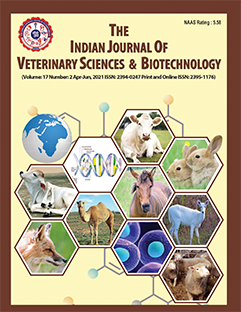Evaluation of Plant-Based Acaricides for Tick Control in Cattle: A Sustainable Alternative
DOI:
https://doi.org/10.48165/ijvsbt.21.3.05Keywords:
Cattle, Cortisol levels, Haematological analysis, Plant-based acaricides, Tick controlAbstract
Tick infestations pose a major challenge, reducing animal health, productivity, and profitability while also transmitting haemoprotozoan and rickettsial diseases. Excessive reliance on chemical acaricides has led to environmental concerns, harm to non-target species, and the emergence of acaricide-resistant ticks, necessitating sustainable alternatives. This study evaluated the acaricidal efficacy of deltamethrin as standard treatment, polyherbal readymade spray, aqueous extracts from Annona squamosa (sugar apple), and Polyalthia longifolia
(Ashoka) as eco-friendly tick control measures. A total of 71 cattle was selected and assessed for tick counts, haematological parameters, and cortisol levels. The study revealed the highest tick reduction with polyherbal readymade spray, followed by the combined and individual plant extracts with significant improvement in haematological parameters in treated groups by Day 28, while untreated cattle showed reverse trend. Similarly, cortisol level, elevated due to infestation, normalized in treated groups but worsened in controls, indicating persistent stress. These findings highlight the potential of plant-based acaricides as effective and sustainable alternatives for tick management in cattle.
Downloads
References
Belsare, B. H., Pawar, P. D., Chigure, G. M., Mhase, P. P., Mhaisekar, N. R., & Dhaygude, V. S. (2025). Assessing the prevalence of hard ticks in dairy cattle across diverse agro-climatic zones of Western Maharashtra. The Indian Journal of Veterinary Sciences and Biotechnology, 21(2), 85-88.
Bhikane, A.U., Jadhav, R.K., Jadhav, A.S., Khillare, B.S., & Ghadge, R.S. (2018). Acaricidal potency of polyherbal spray against Rhipicephalus microplus and Hyalomma anatolicum infestation in cattle. Journal of Parasitic Diseases, 42(1), 34-38.
Goswami, R., Arora, N., Mrigesh, M., & Arya, D. (2024). Impact of tick infestation on haematological and biochemical profiles in cattle: A comparative study. International Journal of Advanced Biochemistry Research, 8(6), 579-583.
Ilham, M.O., Razzig, A.A.A., Elhaj, M.T., & Mohammed, Y.O. (2014). Acaricidal activity of crude extract of Annona squamosa against Hyalomma anatolicum (Ixodoidea: Ixodidae). Alternative and Integrative Medicine, 3(173), 2.
Kachhawa, J.P., Kumar, S., Sharma, A., Singh, A.P., & Ahuja, A. (2016). Studies on alterations of clinical and haemato-biochemical parameters before and after treatment in calves naturally infected with theileriosis. Veterinary World, 9(12), 1381.
Katkar, K.V., Suthar, A.C., & Chauhan, V.S. (2010). The chemistry, pharmacologic, and therapeutic applications of Polyalthia
longifolia. Pharmacognosy Reviews, 4(7), 62.
Katuri, R.N., Das, G., Singh, A.K., Chalhotra, S.K., & Nath, S. (2017). Comparative efficacy of deltamethrin and chlorpyriphos in bovine ticks in and around Jabalpur. Journal of Parasitic Diseases, 41, 713-715.
Kaur, D., Jaiswal, K., & Mishra, S. (2015). Studies on prevalence of ixodid ticks infesting cattle and their control by plant extracts. Journal of Pharmaceutical and Biological Sciences, 10(6), 1-11.
Khillare, R.S., & Kaushal, M. (2021). Role of livestock sector in Indian economy. Agrimeet e Magazine, 1(11), 1-6
Kumar, A.K., Vihan, V.S., & Sharma, H.N. (2010). Haematological and biochemical effects of tick infestation in common Indian goat. Advances in Bioresearch, 1(1), 163-168.
Kumar, M., Changan, S., Tomar, M., Prajapati, U., Saurabh, V., Hasan, M., & Mekhemar, M. (2021). Custard apple (Annona squamosa L.) leaves: Nutritional composition, phytochemical profile, and health-promoting biological activities. Biomolecules, 11(5), 614.
Miraballes, C., Taño, M., & Riet-Correa, F. (2022). Evaluation of the one-side tick counting technique and of the level of infestation of bovines with Rhipicephalus microplus. Experimental and Applied Acarology, 86(3), 443-453.
Parte, S.G., Patil, R.D., Patil, M.A., Patel, N.S., & Chavan, J.A. (2014). Utilization of herbals for the managements of cattle ticks. International Journal of Current Microbiology and Applied Sciences, 3(10), 228-232.
Varadharajan, A., & Gnanasekar, R. (2019). Acaricidal activity of herbal extracts against cattle tick (Rhipicephalus microplus). The Pharma Innovation Journal, 8(1), 609-611.
Downloads
Published
Issue
Section
License
Copyright (c) 2025 Indian Journal of Veterinary Sciences and Biotechnology

This work is licensed under a Creative Commons Attribution-NonCommercial-NoDerivatives 4.0 International License.




